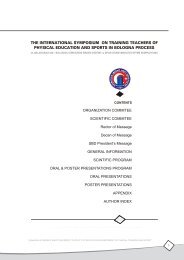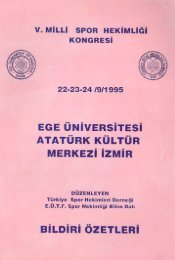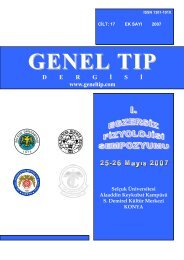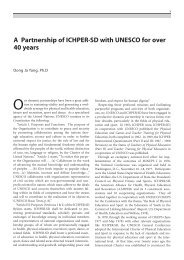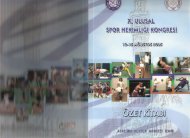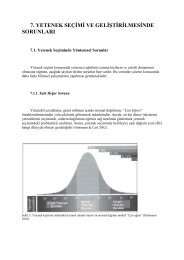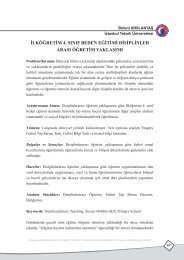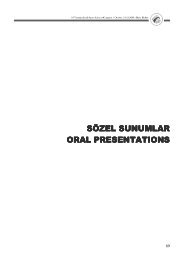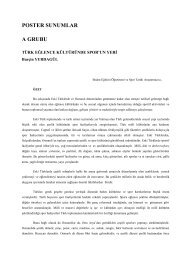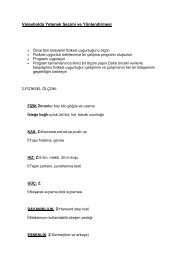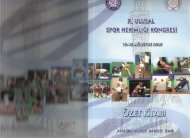KARDÄ°YORESPÄ°RATUVAR EGZERSÄ°Z TESTLERÄ° ... - Spor Bilim
KARDÄ°YORESPÄ°RATUVAR EGZERSÄ°Z TESTLERÄ° ... - Spor Bilim
KARDÄ°YORESPÄ°RATUVAR EGZERSÄ°Z TESTLERÄ° ... - Spor Bilim
Create successful ePaper yourself
Turn your PDF publications into a flip-book with our unique Google optimized e-Paper software.
7.ULUSLARARASI SPOR BİLİMLERİ KONGRESİ27-29 EKİM 2002KONGRE - PANELLERconcluded that differences in physique and performance at various levels of competition compared to nonathleticprototypes may be used to ―infer selective and training factors‖.The relevance of V O2max in establishing physiological characteristics of young Croatian soccer playerswas examined by Jankovic et al. (1997). Their subjects were 47 members of the national teams spanning ages15 to 17 years who were assessed for heart volume, V O2max, ventilatory responses to a graded treadmill test,a range of muscular strength tests as well as limb speed in the dominant hand and leg. Whilst height andweight coincided with norms for the age range, the cardiorespiratory measures were well above normalpopulation values. The sample was sub-divided into those who became top-level professionals - either inCroatia, Germany, Italy or England – and those who did not progress beyond competing in regional leagues(deemed unsuccessful). Those who were successful were superior in height, heart volume, respiratorymeasures, V O2max and leg speed. The authors concluded that aerobic power can be a useful test in theselection of soccer players aged 15-17 years. This research represents one of the few longitudinal observationson elite players, even though physiological measures were not followed through into the subjects‘ professionalyears.Maximal oxygen uptake and performance in an intermittent endurance test have both demonstrated acorrelation with work-rate in a game in both junior and senior players. In adult professional soccer players theaerobic power, as indicated by V O2max (Reilly, 1994a,b) and an intermittent endurance test (Bangsbo, 1994),is correlated with distance covered in a competitive game. The same relationship applied in 16 members (aged16.1 SD = 0.7 years) of the Australian Institute of <strong>Spor</strong>t Association soccer squad for 1990. The work-ratewas not significantly related to anaerobic capacity as determined in a treadmill run lasting 73.5 (±8.4) s.Separating those players already highly selected and exposed to systematised training for national teamsmay not be so easily achieved. Franks et al. (1999) divided their sample of 66 elite England International under-16 players exposed to two years of specialist training. A 12-year intake of players was analysed, divided intothose that suceeded in signing a contract as a full-time professional and those who did not acquire aprofessional contract on graduation. The groups could not be discriminated on the basis of anthropometry(height, weight, skinfolds), V O2max or sprinting performance (15 m, 40 m). It was concluded that in a highlyselect group of under-18 players, other more complex factors determined the players‘ employability asprofessionals. Nevertheless, the players overall had high anaerobic and aerobic performance with V O2maxvalues approaching 60 ml.kg. -1 min among the outfield players irrespective of positional role. When positionalroles were examined (confirmed by coaches‘ assessments) significant differences were evident, mainly amongthe anthropometric measures. Goalkeepers were the tallest and heaviest, had more body fat than the others;the forwards were the smallest whilst the midfield players had the lowest body mass and body fat.Limited data are available with respect to the anaerobic power of young soccer players. Caru et al.(1970) tested 95 soccer players between 14 and 18 years of age. They found that these players had highervalues than non-athletes of similar ages. Nevertheless, in recent years emphasis has been placed on sprintperformance tests for talented young players and these procedures have yielded useful reference data forperformance.Anaerobic performance measures have also included short all-out runs. Ribeiro and Sena (1997) used 5sprints of 30 m with 90 s rest between the repetitions in assessing young players in Porto FC. The subjectsincluded 33 boys aged 12 to 14, 23 in the age-group 15 to 16 and 26 in the age group 17 to 19 years. Speedimproved with age but for each group the forwards were the fastest whereas the goalkeepers were the slowest.The intermittent field test designed by Lindquist and Bangsbo (1993) was administered to 122 playersranging from 10 to 19 years of age in order to determine the intermittent exercise performance of young soccerplayers. Results provide a useful database for reference purposes against which fitness test measures of agematchedyoung players could be compared. Except for an apparent plateau in the group aged 15, there was asystematic inprovement between years in the total distance covered in the test. There was a significant linearcorrelation (r=0.65; P



